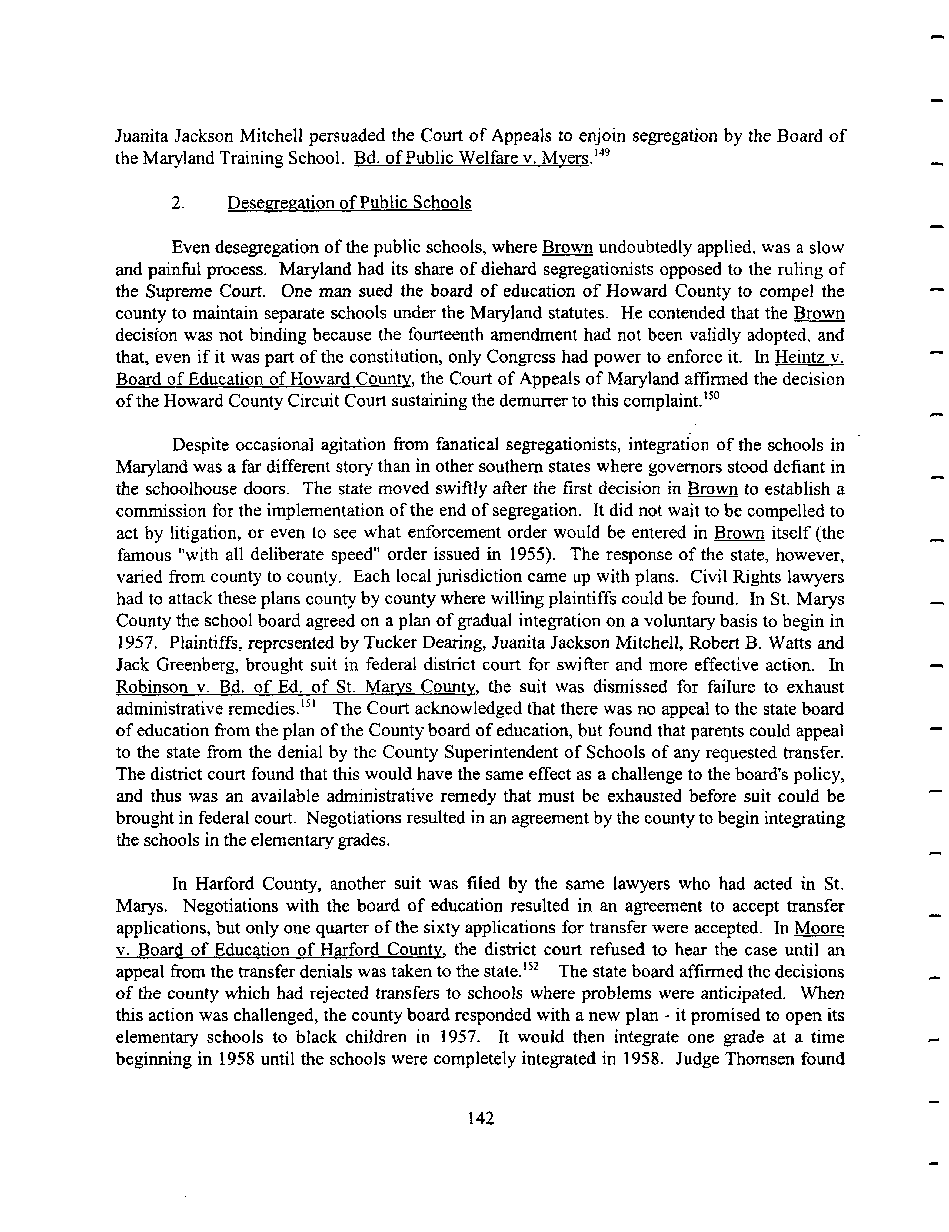|
Juanita Jackson Mitchell persuaded the Court of Appeals to enjoin segregation by the Board of
the Maryland Training School. Bd. of Public Welfare v. Myers.149
2. Desegregation of Public Schools
Even desegregation of the public schools, where Brown undoubtedly applied, was a slow
and painful process. Maryland had its share of diehard segregationists opposed to the ruling of
the Supreme Court. One man sued the board of education of Howard County to compel the
county to maintain separate schools under the Maryland statutes. He contended that the Brown
decision was not binding because the fourteenth amendment had not been validly adopted, and
that, even if it was part of the constitution, only Congress had power to enforce it. In Heintz v.
Board of Education of Howard County, the Court of Appeals of Maryland affirmed the decision
of the Howard County Circuit Court sustaining the demurrer to this complaint.150
Despite occasional agitation from fanatical segregationists, integration of the schools in
Maryland was a far different story than in other southern states where governors stood defiant in
the schoolhouse doors. The state moved swiftly after the first decision in Brown to establish a
commission for the implementation of the end of segregation. It did not wait to be compelled to
act by litigation, or even to see what enforcement order would be entered in Brown itself (the
famous "with all deliberate speed" order issued in 1955). The response of the state, however,
varied from county to county. Each local jurisdiction came up with plans. Civil Rights lawyers
had to attack these plans county by county where willing plaintiffs could be found, hi St. Marys
County the school board agreed on a plan of gradual integration on a voluntary basis to begin in
1957. Plaintiffs, represented by Tucker Bearing, Juanita Jackson Mitchell, Robert B. Watts and
Jack Greenberg, brought suit in federal district court for swifter and more effective action. In
Robinson v. Bd. of Ed. of St. Marys County, the suit was dismissed for failure to exhaust
administrative remedies.151 The Court acknowledged that there was no appeal to the state board
of education from the plan of the County board of education, but found that parents could appeal
to the state from the denial by the County Superintendent of Schools of any requested transfer.
The district court found that this would have the same effect as a challenge to the board's policy,
and thus was an available administrative remedy that must be exhausted before suit could be
brought in federal court. Negotiations resulted in an agreement by the county to begin integrating
the schools in the elementary grades.
In Harford County, another suit was filed by the same lawyers who had acted in St.
Marys. Negotiations with the board of education resulted in an agreement to accept transfer
applications, but only one quarter of the sixty applications for transfer were accepted. In Moore
v. Board of Education of Harford County, the district court refused to hear the case until an
appeal from the transfer denials was taken to the state.152 The state board affirmed the decisions
of the county which had rejected transfers to schools where problems were anticipated. When
this action was challenged, the county board responded with a new plan - it promised to open its
elementary schools to black children in 1957. It would then integrate one grade at a time
beginning in 1958 until the schools were completely integrated in 1958. Judge Thomsen found
142
�
|

